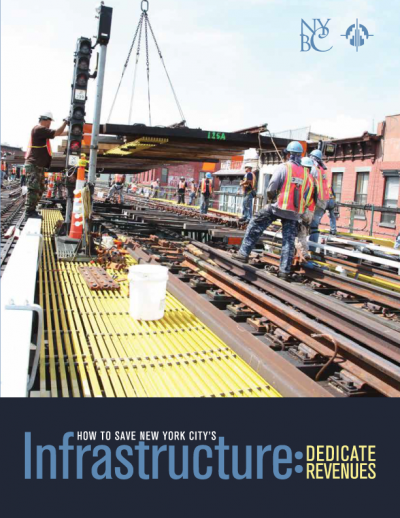
How to Save New York City's Infrastructure: Dedicate Revenues
Executive Summary
There have been periods in New York City's history, most notably during the fiscal crisis of the 1970s, when infrastructure was neglected with disastrous results.
The most resonant images of this decline come from the subway system of this era: track and signal failures due to deferred maintenance were common. These and other equipment failures led to train delays, entire subway lines being taken out of service, and several well-publicized accidents.
The City's roadways fared little better during this time. When a portion of Manhattan's elevated West Side Highway collapsed in 1973, inspectors found that much of the roadway was unsafe, and the road was closed from the Battery all the way to 57th Street. The West Side Highway remained out of service and was not fully replaced until 2001.
Recent history has been far more encouraging. Looking at capital expenditures in 2011, the Building Congress found that government invested more than $18 billion in that one year alone throughout the five boroughs, funding general upkeep, as well as critical network expansions including the Second Avenue Subway, the Third Water Tunnel, new public schools, and parks.
However, the public sector has relied increasingly on borrowing to fund these improvements. While debt financing is vital and entirely appropriate, as it seeks to spread large upfront costs over the generations of New Yorkers who will benefit, it also increases the cost of projects. All levels of government face a future of having to devote increasing portions of their revenues just to meet debt service obligations, leaving less money available for future capital needs.
This report looks closely at how New York City's infrastructure is paid for and the limitations of existing funding streams. The Building Congress in this report recommends new, dedicated revenue sources to maintain, grow, and strengthen the City's infrastructure network. Most of the new revenues proposed here are premised on the "user pays" model, linking fees and charges directly to the networks that require upkeep and new investment.
Government must also approach capital program management more strategically. Use of publicprivate partnerships should be expanded to open up opportunities for creative project financing and more efficient project delivery.
The report also recommends greater reliance on transparent, independent public entities to receive dedicated revenues, finance capital projects, and ensure new funds are spent only for their intended use.




